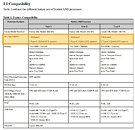- Joined
- Oct 9, 2007
- Messages
- 47,670 (7.43/day)
- Location
- Dublin, Ireland
| System Name | RBMK-1000 |
|---|---|
| Processor | AMD Ryzen 7 5700G |
| Motherboard | Gigabyte B550 AORUS Elite V2 |
| Cooling | DeepCool Gammax L240 V2 |
| Memory | 2x 16GB DDR4-3200 |
| Video Card(s) | Galax RTX 4070 Ti EX |
| Storage | Samsung 990 1TB |
| Display(s) | BenQ 1440p 60 Hz 27-inch |
| Case | Corsair Carbide 100R |
| Audio Device(s) | ASUS SupremeFX S1220A |
| Power Supply | Cooler Master MWE Gold 650W |
| Mouse | ASUS ROG Strix Impact |
| Keyboard | Gamdias Hermes E2 |
| Software | Windows 11 Pro |
The first desktop processors to implement AMD's "Zen 4" microarchitecture will feature integrated graphics as standard across the lineup, according to a Chips and Cheese report citing leaked AMD design documents. Currently, most of the Socket AM4 desktop processor lineup lacks integrated graphics, and specialized "G" SKUs with integrated graphics dot it. These SKUs almost always come with compromises in CPU performance or PCIe I/O. With its 5 nm "Raphael" Socket AM5 desktop processor, AMD is planning to change this, in a bid to match up to Intel on the universality of integrated graphics.
Built in the 5 nm silicon fabrication process, the "Raphael" silicon combines "Zen 4" CPU cores along with an iGPU based on the RDNA2 graphics architecture. This would be the first time AMD updated the SIMD architecture of its Ryzen iGPUs since 2017. The RDNA2-based iGPU will come with a more advanced DCN (Display CoreNext) component than current RDNA2-based discrete GPUs, with some SKUs even featuring DisplayPort 2.0 support, besides HDMI 2.1. By the time "Raphael" is out (2022-23), it is expected that USB4 type-C would gain popularity, and mainstream motherboards as well as pre-built desktops could ship with USB4 with DisplayPort 2.0 passthrough. AMD relies on a discrete USB4 controller with PCI-Express 4.0 x4 wiring, for its first Socket AM5 platform.

View at TechPowerUp Main Site
Built in the 5 nm silicon fabrication process, the "Raphael" silicon combines "Zen 4" CPU cores along with an iGPU based on the RDNA2 graphics architecture. This would be the first time AMD updated the SIMD architecture of its Ryzen iGPUs since 2017. The RDNA2-based iGPU will come with a more advanced DCN (Display CoreNext) component than current RDNA2-based discrete GPUs, with some SKUs even featuring DisplayPort 2.0 support, besides HDMI 2.1. By the time "Raphael" is out (2022-23), it is expected that USB4 type-C would gain popularity, and mainstream motherboards as well as pre-built desktops could ship with USB4 with DisplayPort 2.0 passthrough. AMD relies on a discrete USB4 controller with PCI-Express 4.0 x4 wiring, for its first Socket AM5 platform.

View at TechPowerUp Main Site






 the point of going to chiplets was to eliminate unnecessary BS so Ryzen, Threadripper and Epyc with different I/O could scale off the same chiplet. Upcoming 3D cache will be stacked on the CCDs already, and the CCDs already struggle thermally so no sense in making it even worse.
the point of going to chiplets was to eliminate unnecessary BS so Ryzen, Threadripper and Epyc with different I/O could scale off the same chiplet. Upcoming 3D cache will be stacked on the CCDs already, and the CCDs already struggle thermally so no sense in making it even worse.